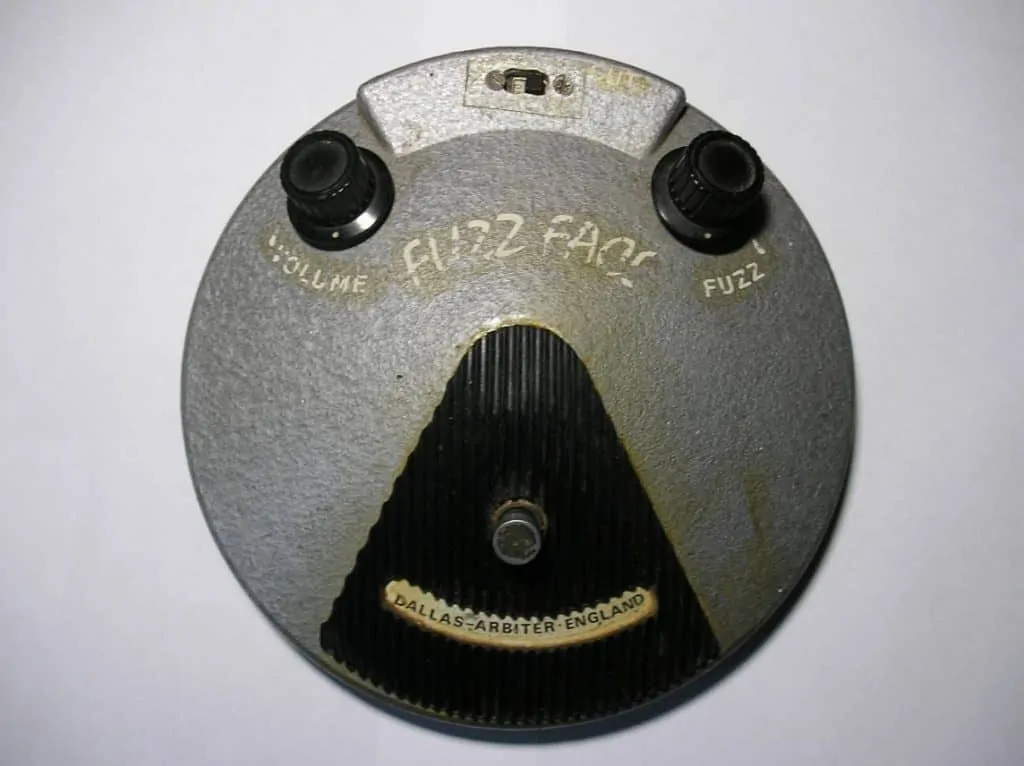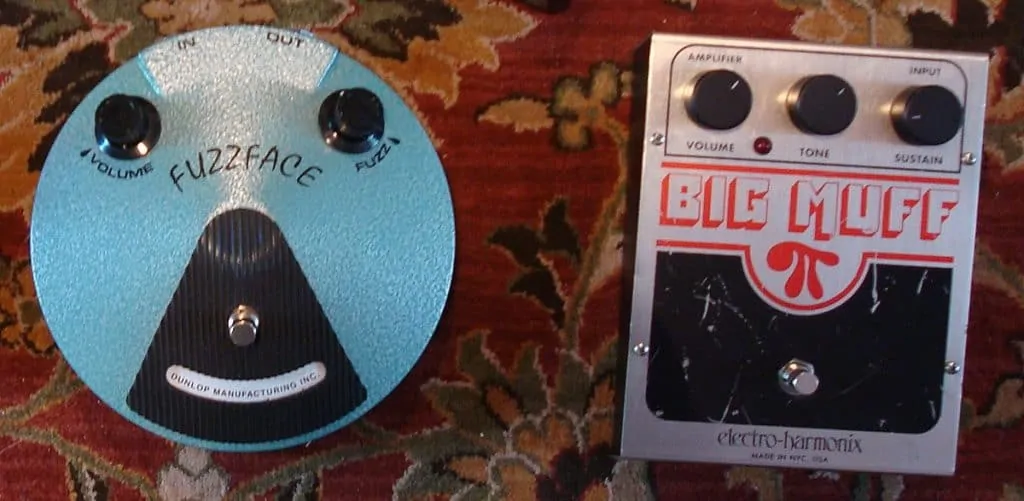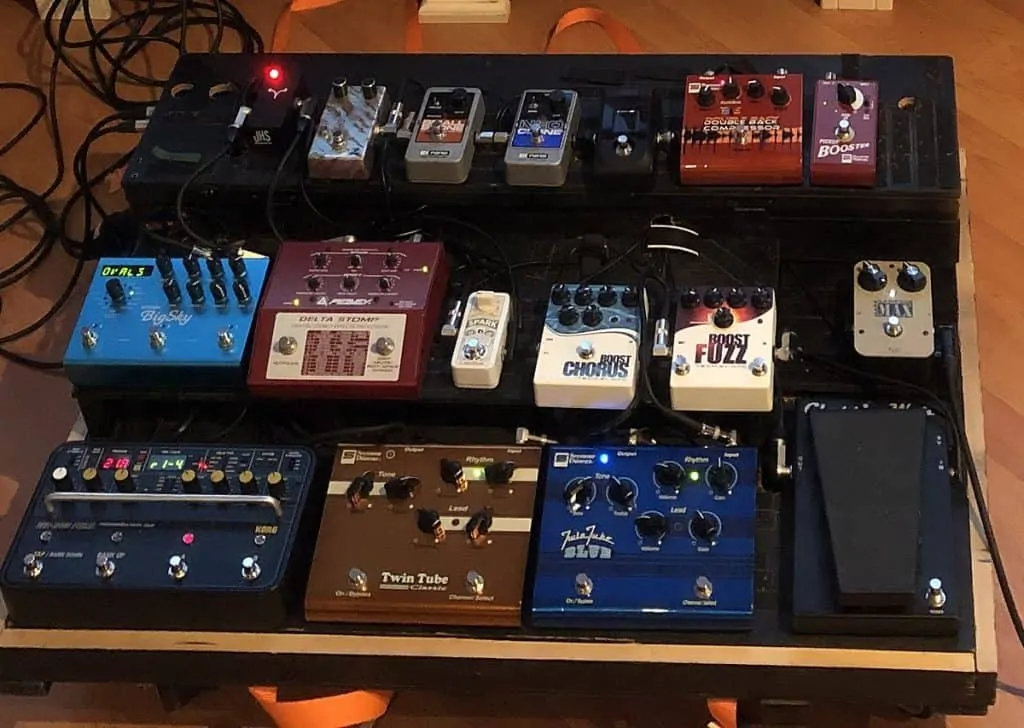Are you about to open your own Fuzz Workshop? This guide will walk you through the key factors you should consider when choosing a fuzz pedal.
Alongside distortion and overdrive, fuzz is the most common effect for electric guitar. It’s also the most diverse, which is why you probably need help to invest your money into the right one.
The first fuze pedals shaped the era of rock n’ roll by making its way into Jimmy Hendrix and Led Zeppelin records.
Foreword: Here’s a song that was recorded with a fuzz pedal:
We’ve already reviewed the Behringer Fuzz pedal as the best budget alternative around, which is why we’re not covering that item in this particular guide.
Additional guitar pedal guides on our site include:
Contents
A buyer’s guide for fuzz pedals
This guide is covering all of the information you need to buy a fuzz pedal.
To help you, I divided this buyer’s guide into 4 sections:
- The Introduction: the basic info you need on flanger pedals so you can make an informed decision.
- Top 6 Fuzz Pedal Reviews: reviews of the best fuzz pedals for electric guitars you can buy right now.
- The technical stuff: a quick guide on this very special effect. It includes what you need to know to buy the right one plus how to use it correctly.
- FAQ: the extra info to cover all of the doubts you might have.
FuzzFace_Effect_Pedal / Djdaedalus / CC BY-SA There’re two main big fuzz pedal families: the Fuzz Factory (currently owned by ZVex); and Face Fuzz, made by different brands following vintage designs.
About Fuzz Pedals
Fuzz is one of the three most common electric guitar effects alongside distortion and overdrive. It’s considered as a distortion, although it features a great degree of flexibility and craziness.
What is a fuzz pedal and how does it sound?
Fuzz pedals go even further than distortion. They take the tone of the guitar and add an extreme clipping known as square-wave clipping. That means these pedals compress the distortion to make a completely new sound.
In a way, the fuzz pedal does what it wants and so it becomes the main character on your signal chain. It’s not subtle as it may overwrite everything else.
Fuzz pedals heavily saturate your tone with a “wooly” and “fuzzy” feel. Another way to describe it is by saying fuzz pedals make you sound like if the amp was broken.
Naturally, they add a huge amount of power and sustain by processing the signal and delivering an all-new artificial tone. The resulting clip is so hard than anything else than leading riffs sound weird.
If I had to describe the sound of a fuzz pedal with one word it would be unpredictable.
Nowadays, most fuzz pedals are constructed the same, but they are wired to mismatched hardware to produce different effects.
The origins of the fuzz effect
The origins of the fuzz pedal date back to the early ‘60s. Back then, the iconic Nashville session guitar player Grady Martin recorded guitar parts for a Marty Robbins song, “Don’t Worry.”
He played with a faulty preamp, an honest mistake that generated a raspy tone with a sound much similar to baritone sax.
A couple of years after, The Kinks recorded their hit track “You Got Me,” with a similar experiment. However, this time it was on purpose. The Kink’s guitar player Dave Davies took the extreme measure of slashing the speakers of his amp with a razorblade as old valve tube amps didn’t have the luxury of a distortion channel.
Both songs became mainstream, so guitar players began seeking new ways to attain similar results without damaging anything. A demand for an effect that could generate these noisy & distorted tones was born, but the coming pedals had to be more reliable than homemade experiments.
The first fuzz pedals
The first fuzz pedals came around back in the early ‘60s alongside rock & roll bands. Early creations were erratic homemade distortions designed to add some dirt to the guitar by introducing noise into the signal.
1962’s Fuzz-Tone, made by Gibson’s affiliate Maestro, was the first commercially successful fuzz pedal. They compacted a tubular preamp to a much simpler design with a “mismatched” germanium circuity for the unpredictable distortion.
Tonebender’s Fuzz Face was the first fuzz pedal to become popular. They were soon made famous by Jimi Hendrix, who bought all of the different Fuzz Face effects available by the late ‘70s. That helped the legendary guitar player create the legendary sounds of his rock gnar.
Popular fuzz guitar players
Soon after the first mass-produced fuzz tones, The Rolling Stones’ Keith Richards recorded the first commercially successful fuzz-filled track in May 1965: “I Can’t Get No Satisfaction.” He used a Maestro Fuzz-Tone (Maestro FZ-1)
Soon after, the fuzz became mainstream gear. Iconic guitar players like Jimmy Page, Mick Ronson, Pete Townsend, and Paul McCartney all started using Tone Benders. Once the fuzz was out of the box, there was no way back.
Most notably, Jimi Hendrix used an octave fuzz pedal for most of his tracks, which includes Purple Haze.
Taking the example a couple of decades forward, The Smashing Pumpkins’ Billy Corgan also used a fuzz pedal for most of the band’s tracks.
More recently, The Black Keys’ Dan Auerbach never goes on-stage without a fuzz stompbox.
The genres of fuzz pedals
Fuzz pedals thrive on alternative rock, grunge, garage, psychedelia, post-grunge, stoner rock, acid rock, punk, hard rock, and similar genres. The sound has been ever-present in rock records since the ‘70s and reached the heights of its popularity in the ‘90s with bands like The Smashing Pumpkins, Blue Oyster Cult, and Candlebox.
The basics of a fuzz pedal
Fuzz pedals are made with either germanium or silicon transistors. These transistors partially “mismatch” the rest of the circuitry, which is why they produce hard clipping.
In basic terms, germanium fuzz pedals are on the vintage side, whereas silicon pedals are the modern alternative.
As for controls, it’s all standard fare. You’re mostly finding two or three knobs, which are:
- Distortion / Fuzz / Level / Gain / Similar: Raises the amount of distortion
- Volume: as it is!
- Tone: trades up lows for highs as you move it up.
Looking at premium-priced pedals you’re going to find additional knobs and a varied set of crazy features.
The trick here is using fuzz pedals with care and subtlety. Experiment first, play live and record later.
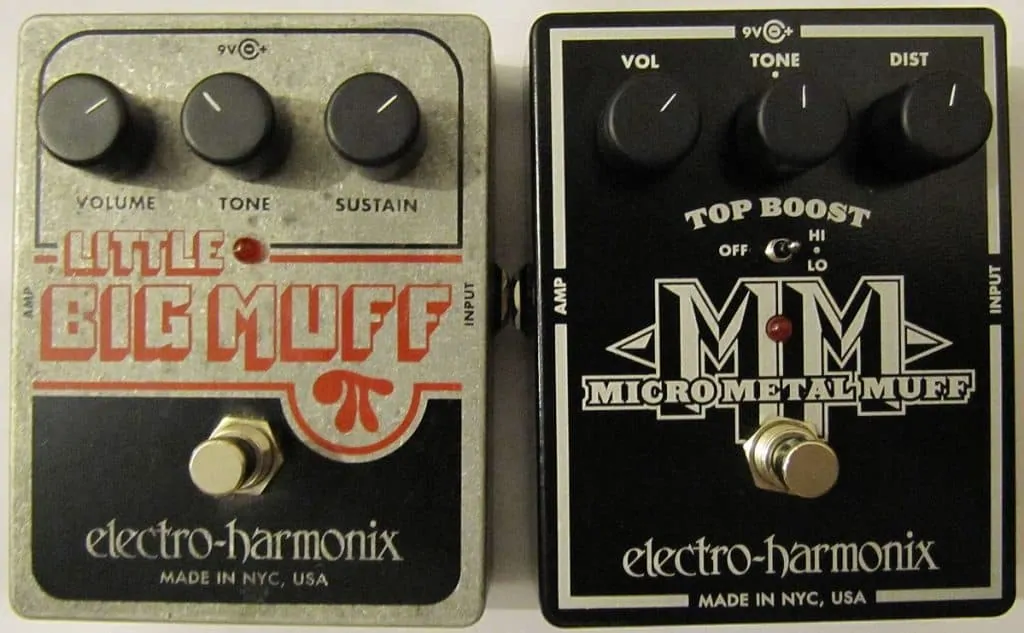
Should you use a flanger pedal?
Fuzz is one of the oldest effects for guitar, and it’s also one of the most enduring. Many guitar players think it belongs to old-school rock music and Hendrix sounds.
Others think it’s a device that tortures your carefully crafted guitar tone better left for experiments and know-it-alls.
And they are right, I’m not going to lie. Taking advantage of a fuzz pedal is troublesome, which is reason enough to grow skeptical.
But there’s good in the effect too. Fuzz pedals are ridiculously expressive and can do much more than just destroy your leading guitar. It produces groundbreaking music, it produces different sounds, and it gives guitar players a unique style.
Overall, a fuzz pedal effect is the best way to add some dirt to your sound.
A fuzz stompbox adds the character and the color that might set you apart from others. It also adds a layer of texture to make your guitar stand on the mix, plus a level of distortion to make it louder and more powerful.
A good fuzz serves for virtually anything and features flexibility for everything. It can go from woolly thickness to flavored raw. It can give you utter despair or just add a slight sensitivity. A fuzz pedal can prepare the stone for that acid rock.
As we’ve learned from Dan Auerbach, Jimmy Page, Billy Corgan, or Jack White, fuzz effects for electric guitar have a massive range of available tones within fairly easy-to-use enclosures.
Ideal for:
Fans of genres like Grunge, post-punk, post-grunge, big riffs, and players looking to add unpredictable colors and distortions to their tone. Most notably, QOTSA and Jimmy Hendrix fans could have an endless Birthday with a fuzz pedal.
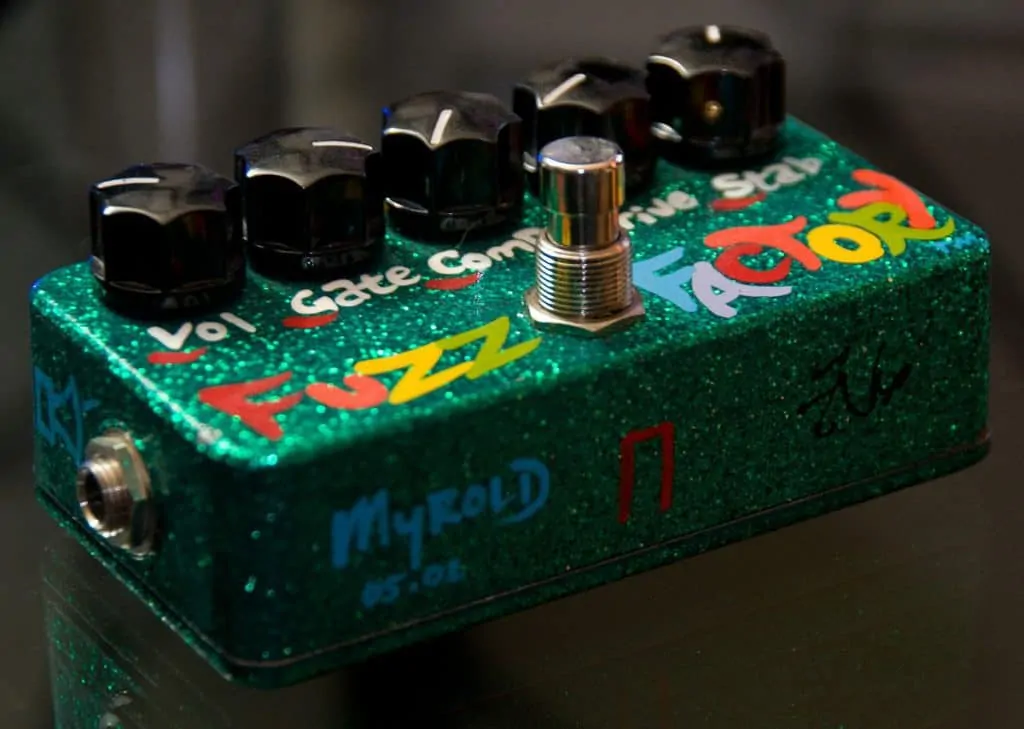
Top 6 flanger pedal reviews
Even the most seasoned guitar players and pedal geeks can have a hard time choosing between the great variety of pedals there’s in the market today.
That’s about to change with our upcoming reviews of the top 6 flanger pedals you can buy right now.
Electro-Harmonix OP-Amp Big Muff Reissue
The best overall fuzz pedal
The Big Muff is part of many bands over the years. The band most associated with the pedal is the Smashing Pumpkins during their 1993 debut album, “Siamese Dream.” When other guitar players began searching for the same sound, they realized Billy Corgan was using a vintage version that was no longer in production.
The OP-Amp Big Muff is the best fuzz pedal you can buy right now. The original Big Muff is one of the most famous pedals in history, and this modern reissue is an ace recreation of the vintage thing.
Because of the availability of parts, the design of the Big Muff shifted over time, being the modern op-amp version a different kind of beast with a different kind of circuit. Billy got lucky to find the specific version he had on a pawn shop.
Don’t worry, though, as the OP-Amp sounds just as good and probably even better. Until now, you could buy it as a boutique clone, build your own, or find a very rare and used original. Lucky for you, now you can bask on the glory days of ‘90s hard rock with all of the fuzz glory the OP-Amp Big Muff offers.
What makes it different and unique is its transistors. Instead of silicon or germanium pieces, The Big Muzz uses two groups of soft-clipping diodes for its particular tone.
Another characteristic that sets this device apart is its LM308 op-amp on the clipping path. This is the same preamp within the famous ProCo Rat distortion pedal, which we already listed as the best metal distortions for electric guitar.
This is a small-sized pedal made of sturdy aluminum and featuring high-quality circuitry. The stompbox features the usual Volume, Tone, and Sustain knobs for easy tweaking. On top of that, it has a switch that bypasses the Tone knob.
The Tone knob can go from sweet silky tones all the way up to the edgy, alternative rock sound that made The Smashing Pumpkins so distinct. The Tone Bypass switch helps guitar players cut through the mix easily. Both aggressive and sweet.
Right in the middle, you’ll find grain, grunge, and crunch. It’s the perfect kind of sound for heavy and thick metal riffs and power chords.
The Muff’s fuzz distortion lends itself for all kinds of heavy genres, which makes this pedal a real essential for rock guitar players. On top of that, it’s both affordable and compact.
Range: Budget / Size: Small / Genres: rock, alternative rock, grunge, heavy metal / Sockets: input , output, power / Transistors: diodes / Controls: Tone, Sustain, Volume, Tone Bypass / Bypass: True Bypass / Power: 9V battery (included) & EHX 9.V power supply (included)
Alternative: Green Russian Big Muff
Maybe you can’t find this particular Muff, the Green Russian Big Muff is a great option as well. It features the same nobs, a similar sound, and a bulkier but still compact enclosure.
As the name suggests, this thing is big, bulky, and features a heavy tone.
The sure-safe alternative: Nano Big Muff
Even cheaper? I got you: the EHX Nano Big Muff. Smaller, cheaper, and equally great sounding.
Albeit this is a different beast. It features the classic “violin” Big Muff, better described as a “wall-of-sound” you’ve probably heard many times before.
It’s modeled after the silver NYC vintage Big Muff, one of the most iconic EHX pedals ever, currently not in production.
You have to know there are various kinds of Big Muffs (Russian, Nano, Op-Amp, Triangle), each one with different properties. If you’re looking for a Big Muff but you don’t know which one is, you can’t go wrong with this NYC budget classic.
ZVex Fuzz Factory
The most versatile fuzz pedal
This thing is crazy. It’s crazy cool, but it’s also crazy as in difficult to use. The Fuzz Factory is a well-known fuzz pedal series that gave birth to psych-rock classics in the ‘70s and the ‘60s.
What you see here is a 5 knobs tamed best featuring 60’s stock germanium transistors plus a modern manipulation of the circuit for improved control and reliability. I’m talking about all-new feedback loops with additional controls to tweak the inner circuit.
That makes the Fuzz Factory versatile and insane in a good way. It can reach tones most pedals can’t even imagine. For example, you can reduce the input voltage so the pedal goes into oscillation, or you could feed the output back to itself; and many other options.
The result is a pedal that needs exploration and careful use. With its five knobs (Volume, Gate, Comp, Drive & Stab) there’s plenty of room for mistakes. Squeals, feedback, hums, howls, pinches are on the menu.
But once you get a hold of this pedal, you’re on your way for fantastic sounds and sonic experimentations. Besides, the Fuzz Factory is about delivering harmonically rich sounds, cool resonant tones, and pitch madness. It’s a wild variety of tones for the experienced player or the encouraged enthusiasts.
As a member of the Fuzz Face family tree, the ZVex Fuzz Factory is just as unusual, unruly, wild, and cool and the rest. And as far as sounds go, it ranges from leading bluesy tones to velcro-fuzz utter destruction.
Range: Premium / Size: big / Genres: blues, classic rock, psychedelic, alternative rock, experimental, indie, hard rock / Sockets: input , output, power / Transistors: Germanium / Controls: Volum / Bypass: True Bypass / Power: 9V battery or 9V power supply (not included)
Alternative: ZVex Wooly Mammoth Vexter (crossover pedal)
The Mammoth Vexter is similar and yet pricier and crazier. The best thing about the mammoth is how it works for both electric basses and electric guitars equally good.
Furthermore, the tones it reaches are pitch-perfect as it has a gentle noise gate to keep it clean and cool. It helps that you got an EQ control to go from bass to treble smoothly.
I name this as the ZVex Wooly Mammoth best fuzz pedal for the home studio.
Here are additional effect pedals for bass guitars.
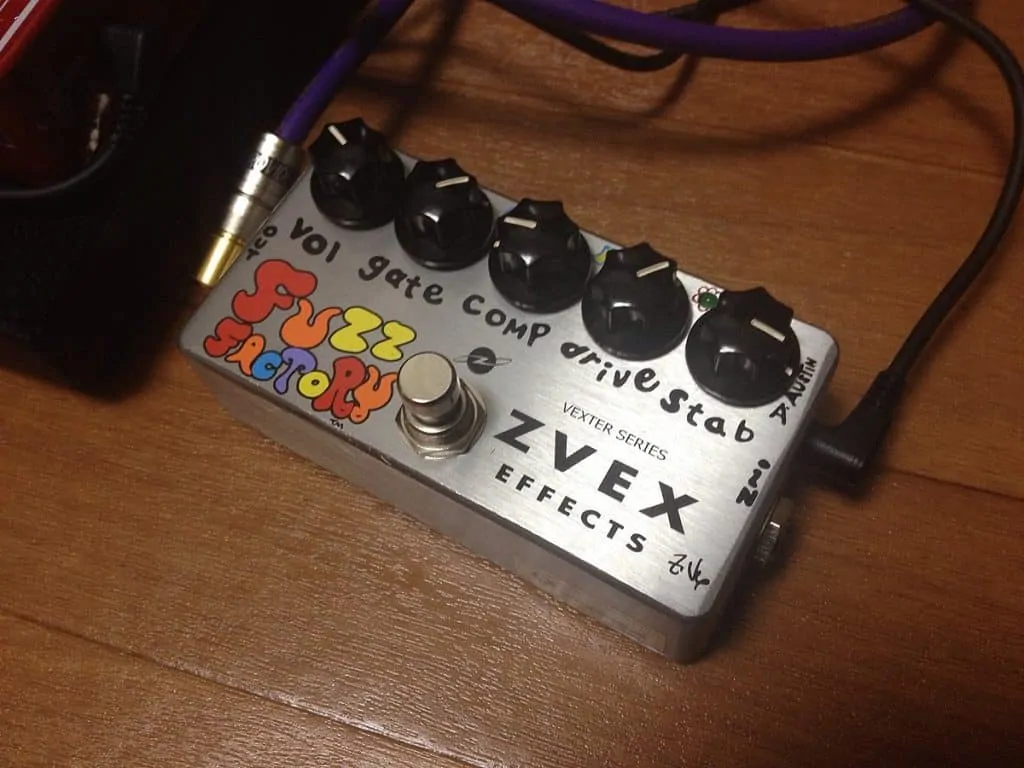
Earthquaker Devices Hoof Hybrid Fuzz Pedal
The Best rocker fuzz pedal
Handmade in Aron, Ohio, the Hoof features a unique mixture of Germanium and Silicon transistors for maximum stability and reliability.
The Hoff is about delivering top-tier dirt with plenty of gain for the heaviest musical genres and the most organic rock&roll sounds. It’s able to create a monstrous tone and the fuzz madness you expect from something so aggressive.
This effect is also simple, user-friendly, and easy to tweak. The musical exploration goes in hand with four intuitive knobs (level, fuzz, shift & tone). In particular, the Shift knob adjusts the mid-range frequency sounds: turn it clockwise for classic scooped mids or the other way around for modern cutting and punchy tone.
Plus, as this is a hybrid fuzz, it keeps the tone consistent and ensures a smooth experience, natural tones, rich sustains, and powerful leading guitars.
I have to note this in an 8-year old pedal that’s still one of the best options, even with so many modern models out there.
Range: Premium / Size: medium / Genres: hard rock, heavy metal, progresive rock, progresive metal, alternative rock, grunge, nu metal, stoner rock, acid rock, sludge, industrial / Sockets: input , output, power / Transistors: Germanium & Silicon (hybrid) / Controls: Level, Fuzz, Tone, Shift / Bypass: True Bypass / Power: 9V battery (included) or 9V Earthquaker Devices power supply (included).
Jim Dunlop FFM3 Jimi Hendrix Fuzz Face Mini
The best vintage fuzz pedal
The Fuzz Face Mini is all about recreating the mythical Jimi Hendrix tones with heavy mid frequencies, dirty lows, and tasty highs.
See, the Fuzz Face is one of the most iconic guitar effects of all time. This small enclosure is designed after the base of a mic stand and has remained the same since its debut in 1966.
The FFM3 is the miniature version of Jimi Hendrix’s JHF1. Circuit-wise, the FFM3 has the same internal circuitry, which includes old-stock silicon transistors designed to cover the same range as the original version.
However, it has the plus of a modern, compact 3D printed circuit board to lower the price, make it smaller, and make it more reliable.
Tone-wise, the FFM3 leans to the mid-range and provides greater note clarity than most of its rivals on the Fuzz Face family tree.
In particular, the FFM3 is made for cranked tube amps and works great alongside overdrive pedals. If you pair this with a cheaper solid-state amp plus an overdrive pedal it’s also going to deliver amazing slicing results.
Keep in mind the “smiley face” mini fuzz pedal has been out of production many times, so, if you’re lucky enough to find one, I’d say go get it. Most guitar players see this because of how well it responds to the guitar’s volume knob, as well as its ability to go from bluesy grit to no-nonsense fuzz.
And all of this comes with two simple knobs, merely volume, and fuzz.
Range: Mid-Level / Size: medium / Genres: classic roc, early metal, ‘60s & ‘70s rock, blues / Sockets: input , output, power / Transistors: Germanium / Controls: Volume, Fuzz / Bypass: True Bypass / Power: 9V battery (included) or 9V power supply (not included).
Dunlop_Fuzz_Face_and_Electro-Harmonix_Big_Muff/ Roadside Guitars / CC BY-SA There’re many companies building Fuzz Face pedals nowadays, being Dunlop and Fender the most successful. They feature a more classical sound when compared to The Big Muff family.
Walrus Audio Janus
The best studio fuzz pedal
It sounds cool, and it looks even cooler. If money isn’t a concern for you, then maybe you could pay for this piece of art. It’s expensive, yes, but it delivers both on design and features.
The Janus is the kind of sneaky pedal everyone will ask about. Plug this on your pedalboard and everyone will mistake you for Muse’s tour guitar player.
The best thing about the Janus is its joystick. Yes, it has a joystick giving you control over the level and the fuzz.
Besides looking like a ton of fun, the joysticks are great partners for the studio. They get even better if you use them on a table for synthesizer keyboards.
In essence, it’s based on the Big Muff with a series of add-on mods like clipping options and extra bass. It’s also way more expressive.
On top of that, the Janus offers onboard tremolo with the joystick controls. On the tremolo side, the joystick tweets depth and rate of both effects.
For studio use, experimentation, record, and fun, there’s no beating the Audio Janus.
Range: Boutique / Size: big / Genres: everything? / Sockets: input , output, power / Transistors: Silicon / Controls: Mode, Bass, Tremolo Level, Fuzz Level, Fuzz Blend, Tremolo Rate, Tremolo Depth, EQ with passive cut / Bypass: True Bypass / Power: 9V battery (included) or 9V power supply (not included).
Orange Fur Coat Octaver Pedal
The best octave fuzz pedal
The Fur Coat adds a switchable octave for extra versatility, power, and leading prowess.
This is one of the best pedals for leading guitar layers looking for versatility because it combined the fuzz effect and the octave effect.
With the EQ in the neutral position, this fuzz delivers the typical vintage sound, fat, warm, and beefy. Moving the EQ to the right and the sound goes from wooly to sharp and aggressive.
Then, turn on the octave, and the sound shifts in a dramatic way. At minimum settings, the octave simply adds a slight degree of tonal shifts, and so it increases the presence a bit.
The shift becomes more pronounced when you crank the octave to the second tone. Take it to the max, and it delivers endless sustain and resonance. It makes your guitar sing.
Range: mid-level / Size: big / Genres: old-school rock & roll, reggae, funk, R&B, EDM, and general rock music / Sockets: input , output, power / Transistors: Silicon / Controls: Volume, Fuzz, EQ, Ocrave / Bypass: True Bypass / Power: 9V battery (included) or 9V/12V power supply (included in some bundles).
Bonus: Donner Guitar Stylish Traditional Fuzz
The best budget fuzz pedal for electric guitar:
It’s not surprising that Donner is currently selling the best budget fuzz pedal around.
This is just a simple fuzz effect with no bells or whistles. The sound comes from 3 knobs (sustain, tone & level) and it’s able to go from vintage sounds to modern fuzz sounds comfortable. It also has a True Bypass switch.
The tone is abundant, great, and similar to a violin. It can make your guitar instantly shine above its peers for a minimal amount of money. It’s nothing special, but it’s dirty, raw, and more than decent start playing some Tool songs.
Lastly, it ships on a sturdy and durable aluminum alloy chassis. It even has a led indicator to show the working state of the stompbox. What a treat!
The technical stuff
Here’s where you’re going to learn everything you need to learn to choose the right fuzz pedal effect for electric guitar.
How to choose the right fuzz pedal for your electric guitar?
Choosing the best fuzz pedal is all about personal taste, as in letting your ears guide you. Check the YouTube demos, the Amazon comments and try it first if you can. Remember that fuzz pedals create a tone on their one, so this is the most subjective guitar effect there is.
In general terms, there are some characteristics you can look for. In particular, choosing between germanium and silicon transistors is the most important decision.
Another thing to care about is the type of fuzz pedal itself. In broad terms, fuzz pedals either follow the Fuzz Face design (with silicon transistors); or the Fuzz-Tone design with Germanium transistors.
FuzzFace_Effect_Pedal_Inside/ Djdaedalus at en.wikipedia / CC BY-SA Fuzz pedals depend entirely on the circuitry and the action of its transistors. That means there are huge differences in tone depending on the transistor types.
Germanium Transistors
Germanium transistors produce the more classical “wooly” sounds we’re expecting from a fuzz pedal. Fuzz Face-styled pedals use germanium transistors. Its sound tends to be warmer, vintage, and strong on the mid-range but subdued on the lows. It’s also more reactive to your playing dynamics.
Its sound takes inspiration from the early days of the effect, and so the result is like a cranked faulty tubular amp. That makes germanium fuzz pedals react great to the volume knob on both your guitar and your guitar amp.
There’re drawbacks, though. For example, changes in temperature may affect the sound and even ruin the pedal. Playing in a hot home studio can make the pedal sound differently than while laying live.
On top of that, they store electrical charges, so they generally lack consistency and sound different day-to-day. Similarly, the same batch of germanium fuzz pedals may also sound different from one another.
Face Fuzz Pedal family
Jimmy Hendrix pioneered the use of Face Fuzz pedals in the late ‘60s. His favorite one was the Dallas-Arbiter Fuzz Pedal Effect. It has germanium transistors and delivers a game-changing tone.
Have you ever seen those famous videos of Hendrix playing on Woodstock? That’s all Fuzz Face magic.
The Face Fuzz Family now belongs to Jim Dunlop, but the majority of their models use silicon transistors instead. The result is consistent and reliable vintage sound with a piercing top-end and balanced mids and lows.
There’re also Jim Dunlop fuzz pedals with germanium transistors, for example, the Fuzz Face Mini Germanium pedal.
Silicon Transistors
The modern silicon transistors produce sharper, more clinical tone, so these fuzz pedals are less wild and more predictable.
These are the contemporary alternatives to germanium material as they offer more consistency and reliability. Plus, they are cheaper and simpler to produce.
That makes silicon fuzz pedals cheaper, simpler, and brighter. They have increased presence in the top-end, which allows players to cut through fat mixes.
Furthermore, they have higher gains as they feature an in-your-face saturated tone.
On the downside, silicon fuzz pedals don’t react to your playing dynamics or your volume knobs.
The Big Muff family is the most popular fuzz pedal series because of its top tier sound, affordable prices, sturdy cases, and crossover features with bass guitars.
EHX Fuzz Pedals
Electro Harmonix fuzz pedals use a different formula, though, which is probably the reason why their Big Muff specimen is so famous.
Their first popular design debuted in 1969 as an affordable option for enthusiasts guitar players looking for huge and bassy fuzz tones.
Another thing that sets Big Muff pedals apart is its EQ knobs plus its sustain control. That makes their models more customizable than most.
In particular, the NYC Big Muff pedal was very popular in the music industry back in the ‘70s. Pink Floyd’s David Gilmours used it as part of its main gear.
Then, The Big Muff became part of bands like The Smashing Pumpkins and Dinosaur Jr to create huge leading rock riffs.
Billy Corgan created the signature sound of his band with a fuzz pedal on 1993’s debut album “Siamese Dream.” He layered various thick rhythm guitars filled with the saturated tones of the Muff.
There’re many iterations of the original Big Muff, being the Green Russian Sovtek Big Muff the most desirable alternative of the bunch.
Green Russian Big Muffs
The Black Keys’ Dan Auerbach is one of the top Sovtek Big Muff users. However, this model is no longer on production, albeit you can find pricier alternatives from boutique builders like Way Huge.
Either way, there’re still other Green Russian Big Muffs around, all of them with similar tones, prices, and qualities.
Digital Fuzz Pedals
Boss is the king of digital fuzz pedals, however, models like the FZ-5 still pale in comparison against the analog counterparts.
Digital fuzz pedals try to emulate vintage sounds with extra-difficult setups like mode switches, dim switches, dual-tone knobs, position knobs, and more.
The good thing is that digital fuzz pedals are cheaper and smaller than the others, so they are pedalboard friendly.
Octave Fuzz Pedals
Lastly, octave fuzz pedals (better known as “octavia pedals” because of Jimmy Hendrix) combine the gnarly tones of the fuzz with a second reproduction of the original input signal raised or lowered a full octave.
They deliver a thick double tone perfect for leading guitar. It’s also particularly perfect for bands with a single guitar player. Most notably, the higher octave can cut even through the harshest mixes.
A famous example is QOTSA’s “Little Sister” hit song.
In Summary
I hope my guide helps you make an informed decision. As you see, fuzz pedals are varied, raw, and unusual.
If you’re looking for an easy, sure-safe alternative to adding some quality dirt to your signal, go try a Big Muff pedal. However, if money is tight, the Donner Stylish pedal is more than okay for beginner and intermediate guitar players.
For an all-out rocker, nothing better than the Hoff. Lastly, you could go for more complex alternatives if you feel sure about your guitar skills.
Large_pedal_board / Sidebart / CC BY-SA Looking for additional pedal alteratives? Check this guitar pedals guide.
FAQ
What’s the best overall fuzz pedal?
At the moment, the Russian Big Muff (EHX OP-AMP Big Muff) is at the top of the charts because it’s the sound of our generation. Growing along The Smashing Pumpkins, Candlebox, Mudhoney, and Sonic Youth made an impression on us.
The ZVex Fuzz Factory is a close second, though, as this is the pedal that can play the vintage Fuzz Face tones.
Both devices were pretty expensive and rare back in the day. The fact that you can simply buy these professional options on Amazon or over the counter is simply wonderful.
Where to place the fuzz pedal on your signal chain?
Fuzz pedals belong in the first position on your signal chain. You can put wah pedals with the true bypass in front of the fuzz pedal, though. However, pedals with buffered bypass should go after your fuzz.
What is “True Bypass”?
The True Bypass option allows you to preserve the quality of the signal going out of the pedal. With the feature on, a pedal effect won’t introduce noises, hums, buzzes, or any unwanted noises to the rest of the signal chain.
What’s the difference between fuzz, overdrive, and distortion?
Finally, you have to understand fuzz, distortion, and overdrive are different effects. Fuzz pedals create a sound on their own with their transistors. Overdrive simply adds a soft-clipping effect to make it sound like going through a cranked tube amp; distortion adds heavier coloration and a heavy-clipping effect but still preserves part of the original sound.

